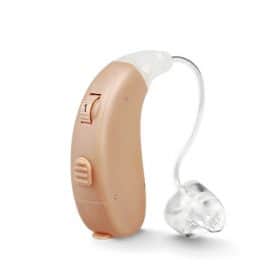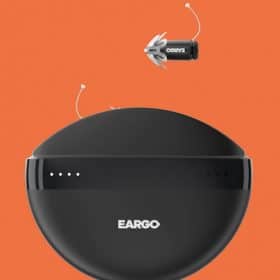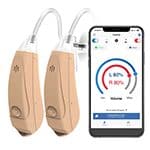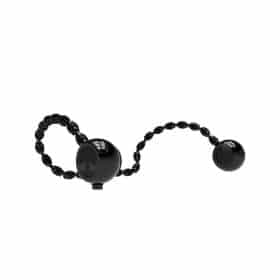Best Hearing Aids of 2023
We do the research for you, and here are our results for the best hearing aid brands and hearing aid devices on the market
What is a Hearing Aid?
A hearing aid is an electronic device designed to improve your hearing in noisy and quiet environments. Hearing aids work by magnifying sound vibrations.
Hearing loss is often treated with hearing aids; while not a cure, it can provide a life-changing improvement to your hearing.
Senior Affair independently recommends products that we believe provide value in the lives of our readers. In addition, we spend countless hours conducting in-depth research on hearing aid devices.
Hearing Aids: How To Choose the Right One?
With so many different models on the market, how do you know which one to choose? Here are some things to consider before buying one.
Have you been thinking about getting a hearing aid but are concerned about how they look and if they actually will help your hearing? By presenting the various hearing aid options on the market, giving you some pointers to look for when buying a hearing aid, and finally explaining how you can get used to wearing a hearing aid, you feel more comfortable making your decision.
They don't design hearing aids to restore your normal hearing capability; they can improve your hearing by amplifying sounds that you're struggling to hear.
How Do Hearing Aids Work?
All hearing aids use the same technology to carry sounds from the environment to your ear with small microphones and a computer chip with an amplifier. Most devices are digital and powered with a traditional hearing aid battery or a rechargeable battery.
What Are Different Hearing Aid Styles?
Today's models vary in price, size, special features, and how you place them in your ear. The most common styles are the smallest, least visible in-ear models. Keep in mind that the smaller units may not have the power you'll need to improve your hearing.
Completely in the canal (CIC) or Mini CIC Hearing Aids
These are molded to fit inside your ear canal, and a completely-in-the-canal hearing aid can improve mild to moderate hearing loss in mature adults.
Completely-in-the-ear-canal hearing aids are the smallest and least visible types and are the least likely to pick up wind noise. They use tiny batteries with short battery life and can be challenging to handle. These usually lack special features like volume control or a directional microphone.
In the Canal Hearing Aids
These are custom-molded to fit in your ear canal partially. In addition, the in-the-canal (ITC) hearing aids can improve mild to moderate hearing loss in adults. However, they are less visible in the ear than the larger styles and have some features that won't fit completely-in-the-canal aids but might be more difficult to adjust because of the small size. Also, you'll have to deal with some earwax blocking the speaker.
In the Ear Hearing Aids
The (ITE) in-the-ear hearing aid has two different styles: one that fills most of the bowl-shaped area of your outer ear called a full shell or one that only fills the lower part called a half shell. Both are equipped with dual-directional microphones and help with moderate to severe hearing loss.
The in-the-ear hearing aids have features that don't fit on smaller styles like volume control and are easier to handle. The battery is larger, so the charged-up life is longer; many have options for rechargeable batteries; they also get clogged with earwax and may pick up more wind noise than the smaller devices and, of course, are more visible in your ear.
Behind the Ear Hearing Aids
The behind-the-ear (BTE) hearing aids are appropriate for any age and hearing loss type and hook over the top of your ear and rest behind the ear. A tube connects the hearing aid to a custom earpiece called an ear mold that fits in your ear canal.
Being traditionally the largest type, current models are more streamlined and barely visible; directional microphones have more amplification than other styles and have rechargeable batteries.
Receiver in canal or Receiver in the ear Hearing Aids
The receiver-in-canal (RIC) and receiver-in-the-ear (RITE) styles are similar to the behind-the-ear hearing aid with the speaker or receiver sitting behind your ear canal. Instead of tubing, they have a tiny wire that connects the piece behind the ear to the speaker or receiver.
A receiver in canal-hearing-aid is usually less visible behind the ear and has features like directional microphones and manual controls; some have rechargeable batteries and are prone to wax clogging the speaker.
Open Fit Hearing Aids
The open-fit hearing aid is a variation of the behind-the-ear hearing aid with a thin tube or the receiver in the canal or receiver-in-the-ear hearing aid with a dome in the ear.
This style keeps the ear canal open, allowing low-frequency sounds to naturally enter your ear and amplify high-frequency sounds through the hearing aid. Perfect for better low-frequency hearing and mild to moderate high-frequency hearing loss.
The open-fit hearing aid is more visible but won't plug your ear like the in-the-ear models, and it may make your voice sound better to you but maybe more challenging to put into your ear due to the noncustom dome.
Additional Features of Hearing Aids
- Remote Controls – some hearing aids have remotes that you can control to adjust the features without touching the hearing aid. For example, some will connect to your cellphone wirelessly and allow control using an app.
- Rechargeable Batteries: Some hearing aids come with rechargeable batteries, making them easier to manage since you won't have to change out the batteries often.
- Noise Reduction: All hearing aids have some degree of noise reduction built-in; this amount varies but offers some wind noise reduction.
- Directional Microphones: These provide improved sound by picking up sounds coming from in front of you and reducing sounds behind or on the side of you. Some hearing aids can focus in one direction; directional microphones can improve your ability to hear in a noisy environment with background noise.
- Telecoils: Telecoils can make it easier to hear when you are talking on a telecoil-compatible telephone. The telecoil reduces background sounds but picks up sound from a hearing-aid-compatible telephone. The telecoils can also pick up signals from public induction loop systems found in some churches and theaters, allowing you to hear a speaker play or movie.
- Synchronization: If you need to wear two hearing aids, they can be programmed to function together so you can make adjustments to one ear that adjusts the other ear.
- Wireless Connectivity: Modern models feature Bluetooth connectivity and connect to your cellphone, music player, computer, or television. It may require an intermediary device to pick up the phone or other signal to send it to the hearing aid.
- Direct audio input: This is a valuable feature to plug-in audio direct from a television, a computer, or a music device with a cord.
- Variable Programming: Some hearing aids allow you to set and store multiple pre-programmed settings for different listening needs and environments.
What to Consider Before Buying a Hearing Aid?
Approximately 48 million Americans are living with significant hearing loss. Even though hearing loss can occur at any age, it's more common as we age. For example, the National Institute on Aging, a part of the National Institutes of Health, estimates that one in three adults between the ages of 65 and 74 has hearing loss. Nearly half of people older than 75 experience hearing difficulties. At some point in our lives, most of us will experience hearing loss or know someone who does.
Does it surprise you to know that only one-in-three adults who could benefit from hearing aids have ever used them? People with hearing loss typically wait an average of seven years before getting treatment.
The American Academy of Audiology lays out some primary reasons that cause people to delay treatment of hearing issues:
- The cost of hearing aids and hearing care.
- The exclusion of hearing aid coverage by insurance companies and Medicare.
- Geographic distance from hearing care providers.
When you're looking for a model that fits your needs, browse the models we've researched for you and:
- Check for warranty: Find out if the hearing aid has a warranty and its details, primarily if they cover the parts and labor for a specific time. Some include office visits or professional services in the warranty.
- Get a checkup: Find out from your doctor if your hearing loss is correctable due to an infection or earwax, and have your hearing tested by a hearing specialist or audiologist.
- Get a referral to a reputable audiologist: If you don't know any audiologists, ask your doctor for a referral to one to assess your hearing and help you choose a hearing aid that meets your needs. If you have hearing loss in both ears, you'll get the best results with two hearing aids.
- Ask about trial periods: Usually, you can get a trial to make sure it works for you, but find out in writing the cost of a test and if this amount is credited toward the final purchase price, and how much is refundable if you want to return it in the period specified.
- Beware of misleading claims: Hearing aids can't restore normal hearing or eliminate all background noise, be careful of any advertisements or companies who claim otherwise.
- Think about the future: Ask if the hearing aid you choose can be upgraded in the future for more power if your hearing gets worse. Of course, hearing aids don't last forever, but you could expect at least five years.
- Plan for the expense: The cost of hearing aids varied widely – from about $1,500 to more than a few thousand dollars, professional fees, remote controls, hearing aid accessories, and other options will cost extra.
Some private insurance policies will cover all or part of the cost of hearing aids – you can check your policy to be sure. Medicare doesn't cover the cost of hearing aids for adults. Medical assistance in most states will cover hearing aids, and if you're a veteran, you may be able to get your hearing aid at no cost through the U.S. Department of Veterans Affairs (VA).
How Do You Get Used To A Hearing Aid?
It will take some time to get used to wearing your hearing aid. As you become accustomed to the amplification, your listening skills improve, and you'll notice your voice sounds different with a hearing aid.
When you first start wearing the hearing aid, keep in mind:
- Hearing aids don't return your hearing to normal: Hearing aids are designed to return your hearing; they will improve your hearing by amplifying soft sounds.
- Seek support and try to stay positive: If you are willing to include your family and friends and practice wearing the device will help you adjust and get used to wearing your hearing aid. Also, you could consider joining a support group for people who have hearing loss.
- Allow time to get used to the hearing aid: It will take time to feel comfortable with it, but the more you use it, the quicker you'll get accustomed to the amplified sounds.
- Practice wearing the hearing aids in various environments: The amplified sound will sound different in different places.
- Make sure to schedule a follow-up appointment: Many specialists offer follow-up visits as part of their services. Take advantage of these appointments to ensure that you are fully benefiting from your hearing aid and to make any necessary adjustments.
If you commit to wearing your hearing aids often and take good care of them, you should have success wearing them. Your audiologist can inform you about the latest advancements in auditory devices, ultimately leading you to discover the ideal model that will effectively address your hearing impairment.
A Quick Look at the Best Hearing Aids of 2023
- Editors Choice – Lively
- Best Value – MDHearingAid
- Most Discreet – Eargo
- Best Adaptive Hearing Aid – Otofonix
- Best Alternative to a Hearing Aid – ChairSpeaker
Hearing Aids Reviews
Editor's Choice: Lively Hearing

100-day money-back guarantee; on-demand care seven days a week.
We like Lively because they have quality, prescription-strength products and a commitment to ongoing customer service. Hearing health professionals suggest that hearing aids can provide greater benefits when they are specifically programmed to your individual type and level of hearing loss.
Lively's business model offers continuous and convenient access to an audiologist, ensuring that you receive professional and personalized expertise. With Lively, you don't have to worry about the hassle and expenses of in-person appointments, as you can get exactly what you need at a fraction of the cost.
Lively allows you to take a hearing test online and have a video consultation with an audiologist before you buy. Then you can pair the hearing aids with a smartphone app to adjust the volume and other settings.
A pair of battery-powered Lively 2 Lite hearing aids cost $1,195. Similar high-tech hearing aids purchased by an audiologist compare at $5,000. A pair of Lively 2 Plus hearing aids cost $1,595. In addition, the company offers financing options that allow you to pay as little as $52 a month.
Cost: $1,195 – $1,195
Battery: Rechargeable & battery-powered options
Bluetooth capabilities: Yes
Adjustment: Remote phone app or audiologist consultation
Warranty & Money-back guarantee: 3-year manufacturer's warranty and 3-year loss-and-damage protection
Financing: Yes
Please read our review of Lively here.
To buy: ListenLively.com
Best Value: MDHearingAid

45-day trial and money-back guarantee
MDHearingAid offers behind-the-ear hearing aids that are affordable on almost any budget.
They design this hearing aid for someone with mild-to-moderately severe hearing loss. The advanced models have noise reduction, feedback cancellation, directional microphones, customized hearing settings, and smartphone capability.
Cost: $400 – $1,599
Battery: Rechargeable & Battery-powered options
Bluetooth capabilities: Yes
Warranty & Money-back guarantee: Limited basic warranty, 45-day return policy.
Financing: Yes
to buy: MDHearingAid.com
Call to buy:
Most Discreet: Eargo
Lifetime support; 2-year warranty; Federal employees may get at no cost.
Eargo has a reputation for having small rechargeable hearing aid devices that nearly disappear when positioned in your ear canal. You won't feel that “plugged up” feeling you get with the larger units; you may forget you're wearing them!
They design these hearing aids for mild to moderate high-frequency hearing loss users.
Eargo uses a unique design that allows for a more natural hearing experience with noise reduction and feedback cancellation.
The company offers financing for as little as $70 per month; if you're a federal employee, you might be able to get your Eargo at no cost.
As part of your purchase, you'll get a personal hearing professional to help you along the way with this customer support for life.
With Eargo, you don't get a consultation with an audiologist; they design these hearing aids to work out of the box. They are not a solution for everyone but might be a good choice for someone with mild to moderate high-frequency hearing loss. You can make simple adjustments by yourself or using your smartphone app or ask the company to assist with programming it remotely.

Cost: $1,500 – $2,950
Battery: Rechargeable
Bluetooth capabilities: Yes
Adjustments: Remote
Warranty & Money-back guarantee: Unlimited repairs and one-time replacement, 45-day return policy.
Best Adaptive Hearing Aid: Otofonix
Support during working hours, with one year manufacturer's warranty
Otofonix offers a behind-the-ear hearing aid that suits just about every user; they have four different environment sound presets. The devices provide crystal clear audio in almost any location you can imagine. Also, they have active noise reduction and adaptive technology to make sure you hear every sound you want to.
The Helix has a long-lasting rechargeable battery and Sona's ability to connect to the smartphone and adjust the settings without touching the device. Adaptive technology is impressive and will automatically adjust to the surroundings.
There are four different models, all feature behind-the-ear designs.
Cost: $398 – $649
Battery: Three models use traditional batteries, which should last for a week. The Helix features a rechargeable battery that lasts a whole day on a single charge.

Bluetooth capabilities: Yes (Sona)
Adjustments: Using the smartphone app
Warranty & Money-back guarantee: One-year manufacturer warranty covers materials and workmanship.

Best Alternative to a Hearing Aid: ChairSpeaker


Perfect if you don't want to wear a hearing aid yet, but would rather find a unique solution instead. You can crank up the sound of this speaker without turning the TV volume up.
By resting the speaker behind your head, you create a “sound cloud” that won't disturb others around you.
With this, you can still hear and listen to the sounds around you and get an immersive sound without wireless connections or batteries.
[accordion title=”Frequently Asked Questions about Hearing Aids”]
[accordion-item title=”Where do you buy hearing aids?”]
You can purchase hearing aids either through a hearing health provider or online directly. Regardless how you buy the device, its most important that your provider performs an evaluation to help you find the right hearing device.
[/accordion-item]
[accordion-item title=”What is the best hearing aid on the market today?”]
Your particular ideal may vary from the next person, but Eargo, Lively and MDHearingAid all make great devices on the market.
[/accordion-item]
[accordion-item title=”Are Costco hearing aids as good as others?”]
Because Kirkland hearing aids are made by Sonova, the world's largest hearing aid manufacturer makes Costco's branded hearing aids, they have a highly regarded reputation.
[/accordion-item]
[accordion-item title=”What is considered the best hearing aid brand?”]
There is no universally best hearing aid brand, however the big six brands are Oticon, Phonak, Resound, Lively, Signia, Widex and Starkey.
[/accordion-item]
[accordion-item title=”Which is better Phonak or ReSound?”]
They both offer high-end features that make them ideal for most users, however Phonak hearing aids tend to be more expensive than ReSound's.
[/accordion-item]
[accordion-item title=”What is the most advanced hearing aid?”]
In America, hearing aid functions aren't regulated or standardized by the FDA, so its objective which model is the most advanced. Oticon's Xceed model has the highest gain output of any hearing aid.
[/accordion-item]
[accordion-item title=”What is the most discreet hearing aid?”]
Any model that is considered completely-in-canal (CIC) will be the most discreet, and most hearing aid manufacturer's offer this style in different models.
[/accordion-item]
[accordion-item title=”Are cheap hearing aids worth buying?”]
We'd advise you to stay away from hearing aids on Amazon or eBay; but MDHearingAid and Lively sells high quality hearing aids for cheap prices. They also have long warranties.
[/accordion-item]
[/accordion]





